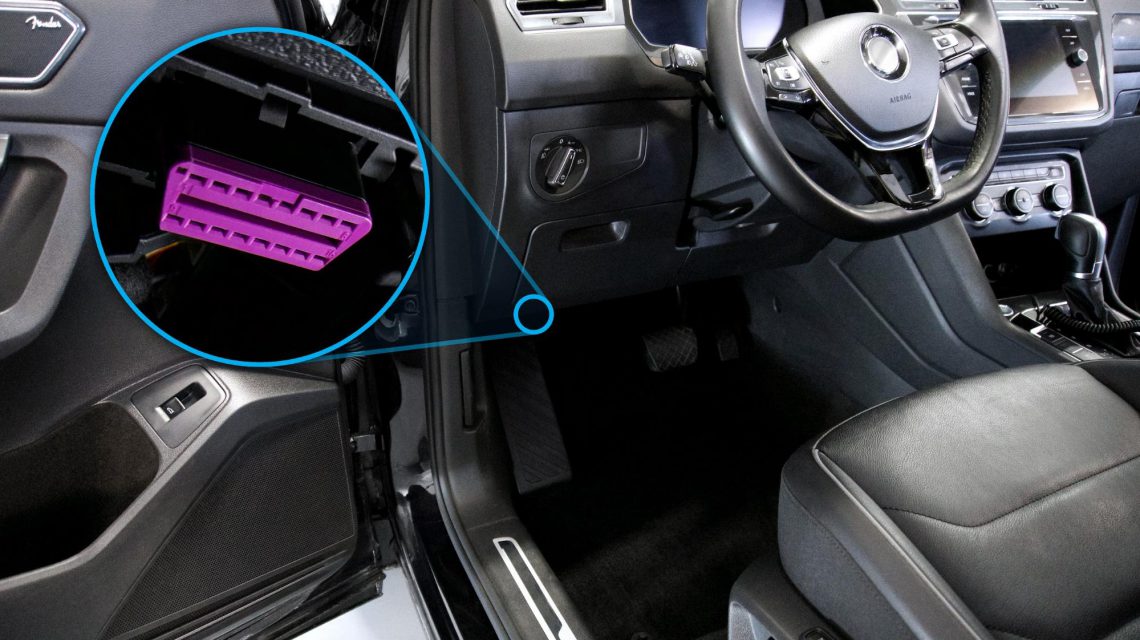Most drivers today are familiar with the lights and indicators on their dashboard, especially the dreaded check engine light. However, did you know these lights are the surface level indicators for a complex system of diagnostic signals that constantly work to monitor the health of a vehicle? From personal vehicles to commercial trucks, these systems, called OBD systems, have become a standard, making vehicle diagnosis and maintenance easier than ever before.
What Is OBD?
OBD stands for On-Board Diagnostics and is a computer system inside of a vehicle that tracks and regulates a car’s performance. This on-board computer system collects information from the network of sensors inside the vehicle, which the system can then use to regulate car systems or alert the user to problems. A technician can then simply plug into the OBD system to collect vehicle data and diagnose the problem. OBD systems have been a great help in helping users better understand vehicle diagnostics.
The history of OBD begins in the 1980s. During this time, vehicle monitoring systems were developed in response to several factors, including:
- Emissions control: One of the biggest reasons for developing OBD was to help reduce vehicle emissions. OBD systems help in this area by monitoring the performance of major engine components for any system failures that could result in increased emissions. OBD is so helpful in this area that it is incorporated into EPA literature on the implementation of the Clean Air Act.
- Electronic fuel injection: In the 1980s, automakers began the widespread production of vehicles with electronic fuel injection. Unlike mechanical fuel injection systems, electronic fuel injection works via computer control, with the computer system monitoring and determining the fuel flow into the engine.
- Electronic components: As electronic fuel injection gained popularity, more electronics became commonplace in cars, increasing the need for more sophisticated monitoring systems to help identify problems more accurately.
Since its initial development, vehicle monitoring systems have undergone several iterations. Today, OBD serves as a standardized system that dictates the connectors and trouble codes used, making it easy for technicians to service a wide range of vehicles quickly and accurately.
How Does OBD Work?
A basic OBD system consists of a central system, a network of sensors, a connection point and indicators, creating a complete monitoring system with standardized access and readability. The OBD system consists of the following components:
- ECU: The central part of the OBD system is the Electronic Control Unit, or ECU. The ECU collects input from various sensors throughout the vehicle. The ECU then uses this data to either control parts of the vehicle, like fuel injectors, or monitor for issues.
- Sensors: There are sensors throughout vehicles covering every area from the engine and chassis to the electronic system itself. Each one of these systems sends codes to the ECU, specifying the source and the parameters of the signal. The ECU then “reads” and interprets this signal.
- DTC: If a sensor sends information to the ECU that falls outside of the normal range, the ECU saves the information as a code called a Diagnostic Trouble Code, or DTC. The DTC code essentially is a list of letters and numbers, which indicate the source and nature of the problem. DTC codes are usually standardized but may be manufacturer-specific. When a DTC is saved, the ECU sends a signal to your indicator light to state that a problem has been found. The DTC can also be pulled by linking a sensor to the connector for the OBD system.
- MIL: When the ECU collects a DTC code, it sends a signal to the vehicle dashboard to turn on the appropriate indicator lights. These lights, known formally as Malfunction Indicator Lights or MILs, provide an early warning system for vehicle malfunctions. Generally speaking, if the light turns on and stays on, the problem is minor. If the light flashes, the problem is urgent.
- DLC: All of the data and DTC codes collected by the ECU can be accessed via the Diagnostic Link Connector or DLC. The DLC port is the point of access for vehicles with OBD systems and is often found beneath the dashboard on the driver’s side of the vehicle, though it may be located elsewhere in commercial vehicles. Current vehicles are made with a standard OBDII system so that any scan tool with a type 2 cable can connect to the type 2 connector.
How Has On-Board Diagnostics Changed Over the Years?
OBD has changed significantly over the years since its introduction in the 1980s. Originally, the system would notify the user that there was a problem using the MIL, but wouldn’t store any information as to the nature of the problem. As cars became more advanced, the number of sensors installed in vehicles expanded, as did the amount of information stored inside the system.
The evolution of OBD systems can be split into two distinct phases based on the type of system popular at the time. These are described in more detail below:
OBD-I
The first OBD systems were proprietary in nature, so they differed between manufacturers. Prior to 1990, the codes, systems and information gathered by each OBD system varied widely from manufacturer to manufacturer. While these systems proved useful, they were unnecessarily complex for technicians to work with — technicians had to purchase a new tool and cable for every vehicle make or had to invest in a scanner that had an array of adapter cables for multiple vehicle makes. Due to the proprietary nature of these systems, users were often forced to go to dealership technicians to diagnose issues.
The push to standardize OBD systems didn’t start until the California Air Resources Board mandated OBD capability in all cars in 1991. The board didn’t issue any standards for these OBDs, however, causing increased difficulties for vehicle manufacturers and users. When the OBD-II standard was implemented in 1994 in response to this need, all previous forms of OBDs were retroactively classified as OBD-I systems.
OBD-II
In 1994, the California Air Resources Board issued OBD-II as a set of standards for OBD systems for all vehicles sold in California. This mandate was officially implemented in the 1996 model year and has been in use ever since. The Society of Automotive Engineers and the International Standardization Organization, known as the SAE and ISO, respectively, also issued standards for how digital information should be exchanged between ECUs and a diagnostic scan tool. The EPA further expanded the use of OBD-II following the passage of the Clean Air Act — as of 2001, 33 states and local areas require regular vehicle inspections to ensure that they meet emission standards, and OBD-II systems are a key part of these inspections.
The OBD-II standards are characterized by several requirements, including the following:
- OBD-II Connector: Modern OBD systems use standardized DLCs called Type 2 Connectors. This allows technicians to use the same cable, a Type 2 Cable, to access the digital communications stored in the OBD system through a port. The location of this port is not standard, but it is usually located under the dashboard on the driver’s side of the vehicle.
- System Monitoring: The EPA requires that OBD systems monitor problems that affect vehicle emissions. Many systems look into other metrics that are not included in this scope as a way to make it easier to find and fix vehicle issues, but the minimum requirement is set.
With this set of standards in place, technicians can service a wider variety of vehicles quickly and easily without the need for manufacturer-specific tools.
What Are the Applications of OBD?
OBD is commonly used across a wide range of vehicle types as an easy way to diagnose vehicle problems. However, the applications of OBD have expanded to cover more specific areas of vehicle monitoring and maintenance, especially over the past few years. Some more specific applications of OBD include:
- Driver behavior monitoring: Automotive-related industries have increasingly used OBD systems as a way to monitor driver behavior. For example, some auto insurance companies offer reduced premiums for drivers that use vehicle data loggers to prove that they exhibit safe driving practices. Additionally, companies may install similar data loggers in their fleet or delivery vehicles to keep an eye on their drivers’ behavior in real time, which can help reduce their liability in the event of an accident or traffic infringement.
- Emissions testing: OBD-II testing is now a common method of testing vehicles for emissions in parts of the U.S. that require it. As part of the OBD-II standard, these systems closely monitor emissions, so inspectors can simply use a scan tool to check for emissions-related trouble codes to ensure that the vehicle is compliant.
- Supplementary instrumentation: Vehicle enthusiasts and professional drivers often use OBD systems to keep an eye on metrics that are not normally displayed in standard vehicles. These metrics may be displayed on custom installations in the vehicle or broadcast to the drivers’ phone.
- Commercial vehicle telematics: Commercial vehicle companies commonly use what is referred to as Generic OBD II to gather information about their fleet. This includes fleet tracking, fuel efficiency monitoring, driver behavior monitoring, remote diagnostics, and more.
How OBD Relates to Commercial Vehicles
Possibly the most extensive use of OBD has been in the commercial vehicle industry, as careful vehicle maintenance is a key aspect of this industry. Commercial vehicle companies have broadly implemented the use of advanced scan tools for OBD2 systems, particularly for the following benefits that OBD-II provides:
- Fast diagnosis: With standardized connectors and DTCs, as well as a detailed DTC system through SAE J1939, commercial vehicle problems can be identified in a matter of minutes. By simply connecting a scan tool to the connector port, technicians can pull valuable diagnostic information that can be used to identify and solve problems before they become expensive repairs.
- Accurate information: With the OBD system, information is collected through the use of sensors rather than by human technicians. This increases the accuracy of the information pulled, reducing the chances that a critical system error may be missed.
- Variety of metrics: OBD systems can be used to collect a wide range of metrics beyond those relating to vehicle maintenance. OBD systems can track driver behavior to ensure that drivers are following legal requirements as well as company protocols. Systems can also be used to broadcast metrics over a secure line, allowing central control to monitor drivers and their vehicles from a remote location with ease.
- Improved compliance: As of 2010, the standards set by the EPA and the Clean Air Act also apply to heavy-duty engines used in trucks over 14,000 pounds. Vehicles operating in certain states need to be inspected regularly to ensure that they comply with these standards. OBD systems monitor emissions to ensure that vehicles meet minimum requirements at all times. They also alert users when emissions exceed acceptable limits so that the issue can be addressed and fixed before an inspection.
- Reduced costs: Between faster, more accurate diagnoses, expanded monitoring capabilities and improved vehicle compliance, OBD systems have helped commercial vehicle companies to reduce costs.



